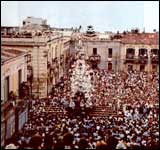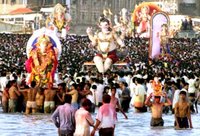Feast of the Madonna of the Letter
The Feast of the Madonna of the Letter is a spectacular civic and religious procession, steeped in folklore and much loved by the locals, that takes place in Palmi on the last Sunday of August.
Preparations for this feast day, the town's most important popular religious celeb ration, begin two weeks in advance, around the feast day of San Rocco, the "co-patron" of the city. There are special masses, folkloric processions and performances of various kinds.
ration, begin two weeks in advance, around the feast day of San Rocco, the "co-patron" of the city. There are special masses, folkloric processions and performances of various kinds.
On the morning of the day itself there are several processions, including the spectacular ride of the Giganti, before the parade proper begins in the early afternoon, heralded by a cannon shot from the local fort.
The main procession is momentous. An enormous cart, 16 metres in height, represents the Ascension of the Virgin to Heaven. On the first level of the cart, the base or Cippu, which represents both the earth and the civil liberties of Palmese citizens, you'll find the apostles, some angels, a priest and a cleric, several young men and the empty seat of the Madonna.
On the levels above this you'll see more angels, clad in beautiful robes and vestments; two huge rotating discs, one golden and the other made of silver, adorned with flower garlands, representing the sun and the moon. Even higher hangs an azure globe representing the Earth, on which is seated the Padreterno, God, and above the Earth, virtually suspended in the void and surrounded by 12 stars, hangs the Animella, the young woman who represents the Madonna.
The celebration is also a bit of a beauty pageant. Every year the nubile young women of the city compete for the title of Animella (little soul) and the honour of representing the living Madonna on the cart as it is pulled through the city. A handsome young man is also chosen to represent God: a set-up which would have medieval theologians dying of heresy or embarrassment, but which makes for an entertaining spectacle.
The legend of the Madonna of the Letter tells how emissaries from the Italian city of Messina arrived in Jerusalem to pay homage to the Virgin Mary after Messina was converted by Saint Paul. The Virgin entrusted them with a letter written in her own hand to take home. Feeling especially blessed by this, the Messinians later incorporated this letter into their religious conception of the Virgin.
 ration, begin two weeks in advance, around the feast day of San Rocco, the "co-patron" of the city. There are special masses, folkloric processions and performances of various kinds.
ration, begin two weeks in advance, around the feast day of San Rocco, the "co-patron" of the city. There are special masses, folkloric processions and performances of various kinds.On the morning of the day itself there are several processions, including the spectacular ride of the Giganti, before the parade proper begins in the early afternoon, heralded by a cannon shot from the local fort.
The main procession is momentous. An enormous cart, 16 metres in height, represents the Ascension of the Virgin to Heaven. On the first level of the cart, the base or Cippu, which represents both the earth and the civil liberties of Palmese citizens, you'll find the apostles, some angels, a priest and a cleric, several young men and the empty seat of the Madonna.
On the levels above this you'll see more angels, clad in beautiful robes and vestments; two huge rotating discs, one golden and the other made of silver, adorned with flower garlands, representing the sun and the moon. Even higher hangs an azure globe representing the Earth, on which is seated the Padreterno, God, and above the Earth, virtually suspended in the void and surrounded by 12 stars, hangs the Animella, the young woman who represents the Madonna.
The celebration is also a bit of a beauty pageant. Every year the nubile young women of the city compete for the title of Animella (little soul) and the honour of representing the living Madonna on the cart as it is pulled through the city. A handsome young man is also chosen to represent God: a set-up which would have medieval theologians dying of heresy or embarrassment, but which makes for an entertaining spectacle.
The legend of the Madonna of the Letter tells how emissaries from the Italian city of Messina arrived in Jerusalem to pay homage to the Virgin Mary after Messina was converted by Saint Paul. The Virgin entrusted them with a letter written in her own hand to take home. Feeling especially blessed by this, the Messinians later incorporated this letter into their religious conception of the Virgin.
Ganeshchaturthi
Ganesh Chaturthi is one of the most popular and joyous of Hindu festivals, the birthday of Lord Ganesha. It is the day most sacred to Ganesha, falling on the 4th day of the bright fortnight of Bhadrapada (August-September)and is observed throughout India, as well as by devout Hindus everywhere.
The festival is celebrated with much enthusiasm and devotion - in some places for ten days. It's said that Ganesh was the creation of Goddess Parvati, who breathed life into a doll which she made out of the dough she was using for her bath so it’s customary for clay figures of the Deity to be made and later thrown into water.

Large Ganesh idols are decorated with flowers, pearls, almonds, cashew nuts, raisins.and coins.These colourful idols are installed atop flower bedecked trucks, tractors, vans, bullock carts and rickshaws while worshippers wearing saffron caps accompany the procession and sprinkle the pink powder -Gulal - while dancing to the tune of drums. Chanting fills the air.
Lord Ganesha is the elephant-headed God who rides on a mouse.
Riding on a mouse, one of nature's smallest creatures and having the head of an elephant, the biggest of all animals, denotes that Ganesha is the creator of all creatures. Elephants are very wise animals; this indicates that Lord Ganesha is an embodiment of wisdom. It also denotes the process of evolution--the mouse gradually evolves into an elephant and finally becomes a man.
This is why Ganesha is portrayed with a human body, an elephant's head and a mouse as a vehicle.
No comments:
Post a Comment